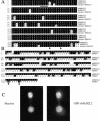Inhibition of Cdh1-APC by the MAD2-related protein MAD2L2: a novel mechanism for regulating Cdh1
- PMID: 11459825
- PMCID: PMC312740
- DOI: 10.1101/gad.897901
Inhibition of Cdh1-APC by the MAD2-related protein MAD2L2: a novel mechanism for regulating Cdh1
Abstract
Exit from mitosis requires the degradation of regulatory proteins including the mitotic cyclins and securin through ubiquitination by the anaphase promoting complex (APC) bound to Cdc20 or Cdh1. Cdc20-APC is regulated through inhibition by the spindle assembly checkpoint protein MAD2. Knowledge of Cdh1-APC regulation is limited to the phosphorylation-dependent dissociation of Cdh1 from APC. We report a novel means of regulating Cdh1 by the MAD2-related gene, MAD2L2. MAD2L2 specifically binds and inhibits Cdh1-APC, paralleling the effect of MAD2 on Cdc20. We suggest that MAD2L2 and MAD2 inhibit the release of substrates from APC and propose a mechanism of inhibition.
Figures





References
-
- Baumer M, Braus GH, Irniger S. Two different modes of cyclin Clb2 proteolysis during mitosis in Saccharomyces cerevisiae. FEBS Lett. 2000;468:142–148. - PubMed
-
- Cahill DP, da Costa LT, Carson-Walter EB, Kinzler KW, Vogelstein B, Lengauer C. Characterization of MAD2B and other mitotic spindle checkpoint genes. Genomics. 1999;58:181–187. - PubMed
-
- Fang G, Yu H, Kirschner MW. Direct binding of CDC20 protein family members activates the anaphase-promoting complex in Mitosis and G1. Mol Cell. 1998a;2:163–171. - PubMed
-
- Funabiki H, Murray AW. The Xenopus Chromokinesin Xkid is essential for metaphase chromosome alignment and must be degraded to allow anaphase chromosome movement. Cell. 2000;102:411–424. - PubMed
Publication types
MeSH terms
Substances
Grants and funding
LinkOut - more resources
Full Text Sources
Molecular Biology Databases
Miscellaneous
